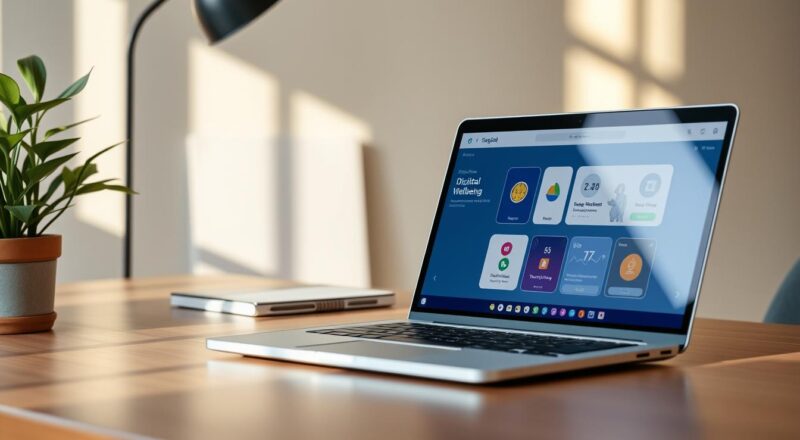In the midst of digital chaos, we find the best digital wellbeing apps to bring us peace. Smartphones connect us non-stop, pushing us towards a digital break. Being present is now valuable, with digital detox apps as our sanctuaries.
Our mental peace is crucial. Using the top digital wellbeing apps is like preserving our calm spaces.
Step into a world where productivity apps and digital wellness tools redefine our time. These apps do more than just limit screen time; they help us focus and be mindful. They guard our digital spaces, making sure our online life improves our real life, not interrupt it.
- Key Takeaways
- Understanding the Need for Digital Wellbeing
- The Rise of Screen Time Management Apps
- The Built-in Power of Android’s Digital Wellbeing
- StayFree: Tailoring Your Digital Experience
- Focus To-Do: Merging Productivity with Digital Wellbeing
- Forest: Gamifying Screen Time Reduction
- One Sec: Encouraging Mindfulness in the Digital Realm
- ActionDash: Beyond Android’s Digital Wellbeing
- Comparing Third-Party Apps with Built-in Solutions
- Tips for Maximizing the Benefits of Digital Wellbeing Apps
- Conclusion
- FAQ
- What are digital wellbeing apps and why do we need them?
- How do digital wellbeing apps affect mental health?
- What are some features of screen time management apps?
- Can Android’s Digital Wellbeing feature help us control our screen time?
- How does StayFree help customize our digital experience?
- What is the Forest app, and how does it encourage users to reduce screen time?
- How does One Sec promote digital mindfulness?
- What additional features does ActionDash offer beyond Android’s Digital Wellbeing?
- Should I use third-party apps or built-in features for managing screen time?
- How can we maximize the benefits of using digital wellbeing apps?
Key Takeaways
- Embrace digital wellbeing apps for a healthier online/offline balance.
- Enhance productivity with tools designed to manage and optimize screen usage.
- Digital detox apps are not just about less screen time but better time management.
- Protect mental health and improve focus with the best digital wellbeing apps.
- Integrate digital wellness tools into daily routines for a comprehensive wellbeing strategy.
- Understand the features and benefits of leading productivity apps in fostering digital wellness.
Understanding the Need for Digital Wellbeing
In our world today, we often find it hard to tell when we’re using our gadgets helpfully or too much. We use technology for almost everything – our jobs, staying healthy, and keeping in touch. It’s crucial to find balance to benefit from our devices without their use taking over our lives.
The Impact of Excessive Screen Time on Mental Health
Too much screen time can hurt our mental health. It can make us stressed, mess with our sleep, and make us feel anxious or sad. Apps that focus on mental health and managing stress are important. They offer ways to ease these problems.
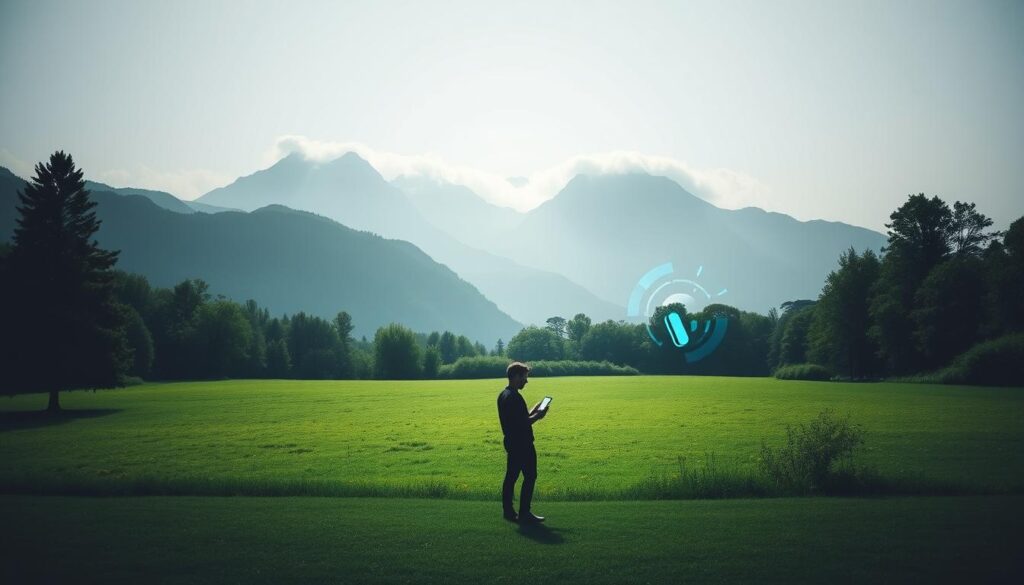
How Digital Wellbeing Apps Can Help
Digital wellbeing apps are key in fighting tech addiction. They help improve our mental health by tracking and managing how much we use our devices. For example, productivity apps help us use technology wisely. They make sure we’re not distracted by it all the time.
| App Type | Primary Function | Benefits |
|---|---|---|
| Mental Health Apps | Stress and anxiety management | Improves mood, enhances relaxation |
| Productivity Apps | Time management features | Increases daily productivity, decreases procrastination |
| Stress Management Apps | Real-time stress tracking and advice | Helps maintain emotional and physical well-being |
The Rise of Screen Time Management Apps
In today’s world, we’re almost always online. That makes digital health apps very important. Screen time management apps are key for controlling how long we’re on our screens. They show we care about staying healthy in a digital world.
RescueTime leads the way in tracking our screen use. It shows us just how much time we spend glued to screens. The need for a break from all that screen time has grown. This has led to more people wanting programs to help them use their devices less.
We need tools that show us how we use our screens. They help us choose how to spend our online time better. Programs to help us disconnect are becoming more popular. They help us break free from always being online.
![]()
But it’s not just about using screens less. It’s about using them smarter. Management apps help us make the time we spend online count. This is crucial now that our lives are so blended with the digital world.
Companies are also starting to use these tools. They help create a better work environment. This shows these apps are valuable not just for us alone but in work settings too.
By using screen time and wellness apps, we can take charge of our digital health. This shows us that smart use of technology can improve our lives. It doesn’t have to take away from our well-being.
The Built-in Power of Android’s Digital Wellbeing
In today’s fast-paced world, it’s important to find a balance between screen time and well-being. Android’s digital wellbeing feature helps users manage their tech use wisely. It integrates wellness apps, making it a full wellbeing strategy.
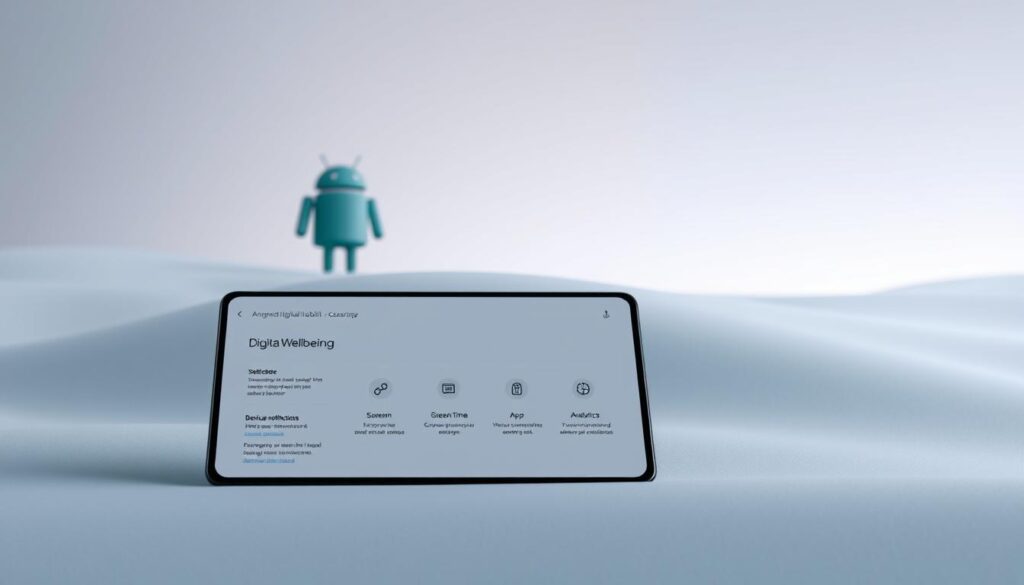
It shines in tracking how much we use our apps. This helps us see our digital habits clearly and encourages a more thoughtful use of tech.
Monitoring App Usage
The tool shows which apps we use most, for how long, and when. Knowing this, we can spot and fix any overuse. This helps us stick to a personalized plan for better mental health.
Focus Mode and Bedtime Features
Focus Mode lets users block distracting apps to stay on task. Bedtime Mode dims screens and mutes calls, protecting our sleep from pesky notifications. These features help us cut down on interruptions and sleep better.
Android’s digital wellbeing tools are vital for a healthy digital life. They help improve our lifestyle and make us more productive.
StayFree: Tailoring Your Digital Experience
StayFree offers a unique way to handle screen time, focusing on better mental health and increased productivity.
Custom Usage Limits and Motivational Reminders
For those wanting to balance their digital life, StayFree is key. It lets users limit time on addictive apps and includes self-care apps in daily routines. Also, it sends reminders to encourage time off screens, promoting activities that fulfill life beyond the digital.
StayFree’s Unique Blocking Features
StayFree stands out by blocking distractions. With its Strict Mode, it ensures users stick to their chosen limits. This helps avoid too much time on sites like Instagram or Facebook. Blocking these distractions aids in maintaining focus and enhancing productivity.
StayFree merges mental health apps and productivity apps into one self-care platform. This makes it vital for controlling your digital space, ensuring technology aids you, not controls you.
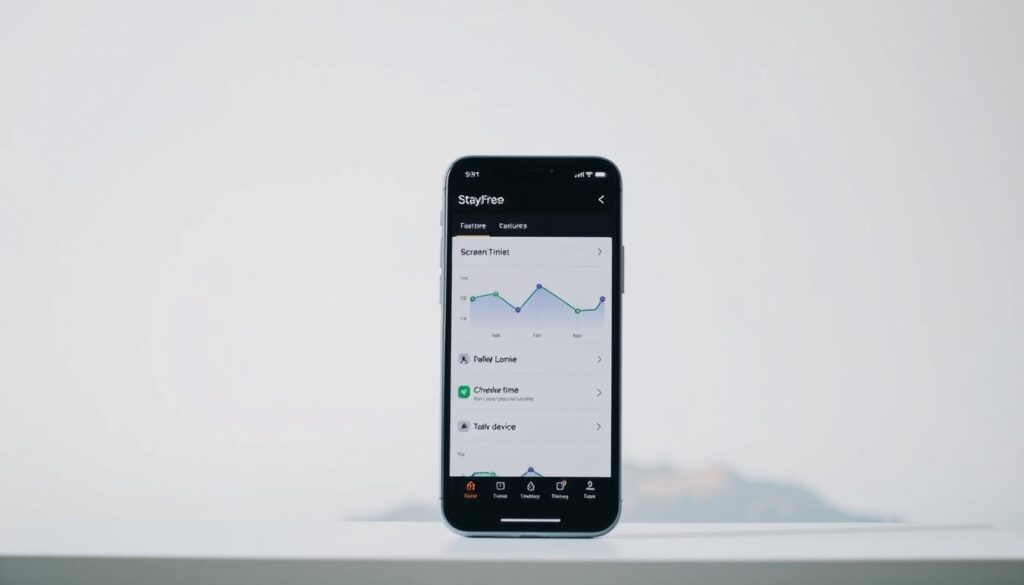
Focus To-Do: Merging Productivity with Digital Wellbeing
Focus To-Do is leading the way in combining productivity apps with mindfulness. It uses the Pomodoro technique and advanced task management. It also includes mental health tools. This mix is a whole new way to manage time and achieve digital wellness. It suits anyone wanting to boost their productivity.
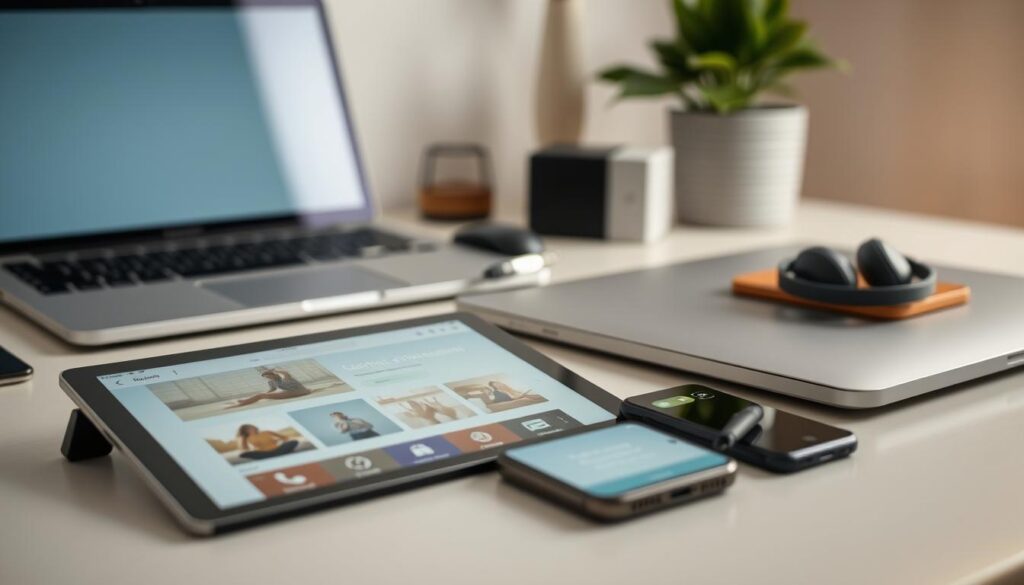
The app works by breaking work into short sprints with breaks. It helps users stay focused by blocking access to distracting apps. This is key for keeping your workflow smooth.
Focus To-Do is useful for many purposes. It helps students, professionals, and anyone wanting to improve mindfulness and productivity. The app’s features easily adjust to fit your needs. This improves not just task management but also your digital habits and mental health.
| Feature | Description | Benefit |
|---|---|---|
| Pomodoro Timer | Focus intervals of 25 minutes followed by a 5-minute break | Enhances concentration and prevents burnout |
| Task Management | Organize tasks with tags, due dates, and priority levels | Streamlines workflow and prioritizes tasks effectively |
| App Blocking | Limit accessibility to selected apps during focus sessions | Minimizes distractions and boosts productive output |
| Analytic Insights | Visual representation of time spent on various tasks | Provides clarity on productivity patterns, assisting in better time management |
In conclusion, Focus To-Do stands out in the digital wellness space. It offers strong task management and can block distractions. Plus, it makes mindfulness a big part of daily productivity. It’s a must-have for anyone wanting to improve their digital and mental health.
Forest: Gamifying Screen Time Reduction
Digital wellness apps like Forest are changing how we balance tech use and personal well-being. It encourages a healthy lifestyle with digital detoxing in a fun way. By letting users grow virtual trees for focusing away from phones, it makes being mindful interesting. Seeing a forest grow can push users to cut down on screen time better than old-style methods.
Read more: What is Silicon Photonics? : Hitachi High Tech Corporation
Read more: Convolutional Neural Network Ultimate Guide in 2025
Read more: AI-Powered Code Generation: How Developers Can Leverage Automation

Lowering screen time in Forest isn’t just about a tree growing in the app. It’s also about real trees being planted, thanks to partnerships with tree-planting groups. This makes users feel good about using their screens wisely. It links digital actions to real-world results, making Forest stand out in promoting a healthy lifestyle.
Virtual Trees for Real-Life Focus
Forest uses game tricks to turn daily digital detox into something fun. Users work towards their goals and see their virtual tree flourish. If they use their phones, the tree fails. This way, the app reminds them to live in the moment and stick to their mindfulness goals.
Real-World Impact: Planting Trees with Screen Time
Forest’s work with tree-planting organizations gives users another reason to stay focused. By growing virtual trees and staying off the phone, users help fund real tree planting. This makes using technology wisely even more rewarding. It helps the planet every time users choose their health over screen time.
One Sec: Encouraging Mindfulness in the Digital Realm
In our fast-paced world, we often rush to check our phones. One Sec is a leading app that promotes mindfulness in using technology. It introduces a brief pause before opening apps to break the cycle of tech addiction.
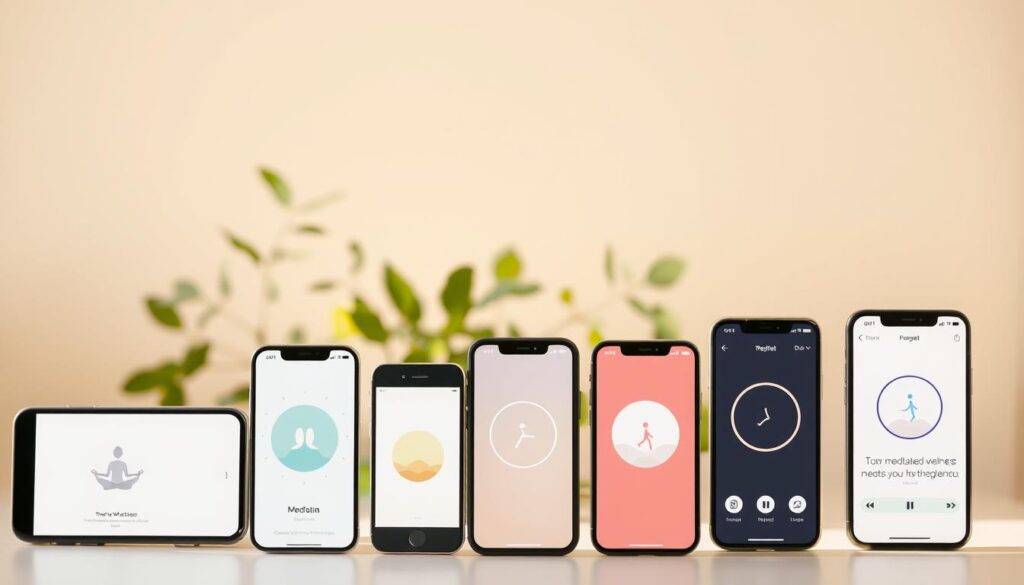
One Sec uses a unique approach to slow us down. It adds a small barrier that makes us think before we act on our impulses. This method is changing how we use mental health apps to handle our digital lives better.
Breaking the Cycle of Impulsive App Checking
Checking apps without thinking is a big challenge today. It hurts our productivity and mental health. One Sec includes a feature like therapy apps, allowing us to stop and think. This helps us form better habits and offers a way to fight tech addiction effectively.
Usage Insights for Conscious Digital Habits
Good self-help apps give useful feedback, and One Sec does this well. It tracks when we choose not to use an app, showing how we’re improving. This encourages us to keep using mindfulness apps and develop healthier digital habits.
ActionDash: Beyond Android’s Digital Wellbeing
ActionDash enhances what’s already in Android, taking screen time tracking up a notch. It gives deeper analysis on our phone use, which is great for people looking to cut back. By offering this detailed info, it helps us be more mindful about our digital habits. This blend of wellness and digital health tools is pretty nifty.
ActionDash is easy to use and builds on Android’s Digital Wellbeing tools. It adds extra features that let you tweak your settings to suit your needs. This is key for anyone wanting to make their digital space work better for them, improving focus and mental health.
Detailed Analytics for a Deeper Understanding
ActionDash goes beyond basic stats to give a real look into how we use our gadgets. This can show us habits that might be messing with our happiness or work. It’s like having a health app that keeps us in check, but for our digital lives.
Customizable Focus Modes to Enhance Productivity
Focus modes in ActionDash do more than just stop notifications. They let us pick the apps we really need when we’re trying to work. This smart planning is a big help in cutting down on screen time. And it keeps us focused, so we’re not lost in our phones.
| Feature | Benefit |
|---|---|
| Real-time Usage Statistics | Gives users immediate feedback on app usage |
| Customized Focus Modes | Helps in blocking distracting apps during focus sessions |
| Detailed Historical Analytics | Offers insights into usage patterns over time |
| User-friendly Interface | Ensures ease of use and seamless integration with device settings |
Comparing Third-Party Apps with Built-in Solutions
Choosing between third-party digital wellness apps and built-in solutions is vital for our digital wellbeing. Android’s Digital Wellbeing and iOS’s Screen Time offer basic screen management tools. They’re easy to access because they come with the device. But they don’t have the depth or flexibility that third-party self-care apps and mental health tracking tools offer.
Apps like RescueTime and Freedom give detailed insights into how we use our devices. They help users control their screen time better by offering detailed data and control features. These apps are great for those who want deep control over their digital use. They let users set goals, see detailed usage, and block distractions on all devices, not just phones.
| Feature | Built-in Solutions | Third-Party Apps |
|---|---|---|
| Integration | High native integration | Requires installation and setup |
| Customization | Limited | Extensive customization options |
| Insights | Basic summaries | Detailed analytics and productivity insights |
So, the choice between third-party and built-in digital health solutions depends on what you need. If you value convenience or in-depth mindfulness applications, there’s something out there for you. Each choice caters to the varied needs of today’s digital users.
Tips for Maximizing the Benefits of Digital Wellbeing Apps
In today’s digital world, it’s vital to use digital detox tools and wellness apps. These aren’t just apps; they’re doors to a healthier way of dealing with technology. By aiming for sensible screen time and adding these tools into our overall mental wellness plan, we can really boost how well we feel.
Setting Realistic Screen Time Goals
Starting with clear, achievable screen time goals is crucial. It’s important to pick online therapy and wellness apps that offer personalized advice. This way, we can better watch and adjust how we use our devices. Checking our usage data helps us make changes to use our screen time better and not let it take over our lives.
Incorporating Apps into a Holistic Wellbeing Strategy
Wellness and lifestyle apps are key for a balanced screen time strategy. For example, apps like Flipd encourage us to practice mindfulness and remind us to take breaks for our mental health. By making these apps a part of our daily life, they help us use technology in a healthier, more mindful way.
- Use digital detox tools to set automatic reminders to take breaks from screens.
- Engage with features in wellness apps that track and reward progress towards your wellness goals.
- Explore features in online therapy apps for guided relaxation techniques to unwind.
Conclusion
The best digital wellbeing apps help us have a healthier tie to our devices. They’re more than just cutting down screen time. They help us take meaningful breaks and deal with tech on our terms. Adding these apps to our daily life means we focus more on valuable digital moments instead of just zoning out.
With tools like Android’s Digital Wellbeing and apps like Forest and StayFree, beating tech addiction is easier. These apps blend into our day-to-day life, bringing better focus, relationships, and joy. They’re not just apps; they’re guides to a calmer, more managed tech experience.
In wrapping up, our goal with these tools should be broad. It’s not only about less screen time. It’s about building a digital world that’s good for our mental well-being, makes us more productive, and improves our life. By smartly using the best digital wellbeing apps, we make our smart devices work better for us, leading to a more balanced life.
Outbound Links
-
https://play.google.com/store/apps/details?id=com.google.android.apps.wellbeing – Android Digital Wellbeing
-
https://www.rescuetime.com – RescueTime
-
https://www.forestapp.cc – Forest
-
https://www.stayfreeapps.com – StayFree
-
https://www.actiondash.com – ActionDash
-
https://one-sec.app – One Sec
-
https://www.focustodo.cn – Focus To-Do
FAQ
What are digital wellbeing apps and why do we need them?
How do digital wellbeing apps affect mental health?
What are some features of screen time management apps?
Can Android’s Digital Wellbeing feature help us control our screen time?
How does StayFree help customize our digital experience?
What is the Forest app, and how does it encourage users to reduce screen time?
How does One Sec promote digital mindfulness?
What additional features does ActionDash offer beyond Android’s Digital Wellbeing?
Should I use third-party apps or built-in features for managing screen time?
How can we maximize the benefits of using digital wellbeing apps?
Get in Touch with SJ Articles
Read more: Tech and Mental Health: Striking the Right Balance for Well-Being
Read more: Empowering India with Agentic AI Solutions
Read more: Convolutional Neural Network Ultimate Guide in 2025


